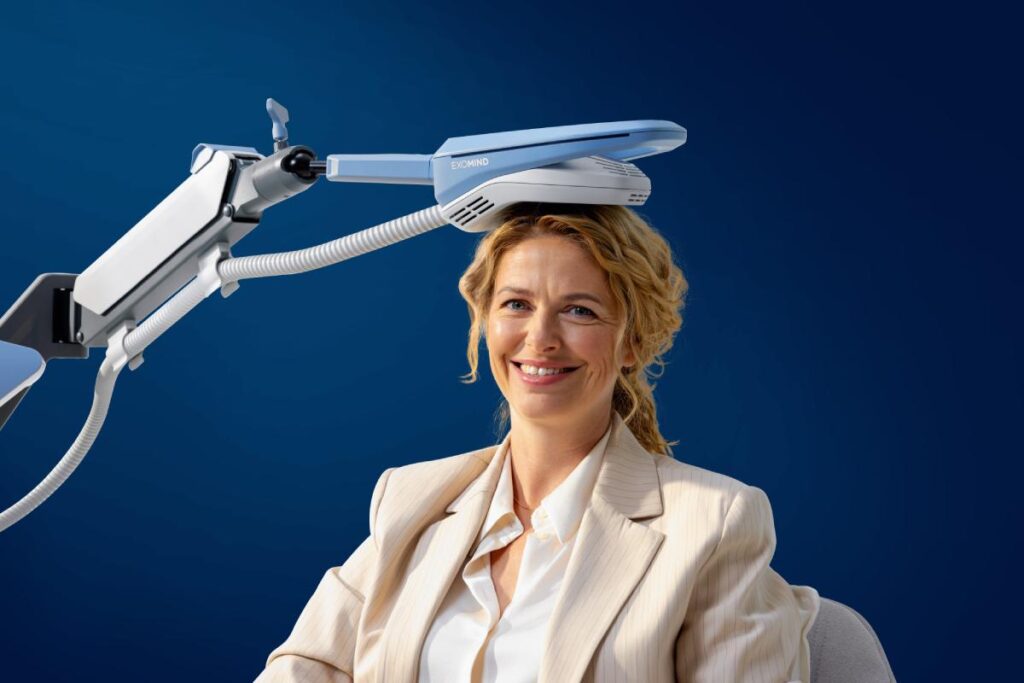
Short answer: for eligible adults, EXOMIND is considered safe, and seizure is the rare serious risk at under 0.01% per session.
For what this looks like in our clinic and a simple session overview, see EXOMIND in Mumbai.
EXOMIND uses focused Electromagnetic pulses on the Left Dorsolateral Prefrontal Cortex of the brain, networks linked to mood and focus. It is non invasive and needs no sedation. Sessions take tens of minutes per visit. A doctor screens your health, sets dose by motor threshold, and checks comfort in real time. Most people go back to work the same day.
This page is general information, not medical advice.
Who should wait
- Active electronic implants such as pacemakers or cochlear implants
- Magnet sensitive metal in or near the head that cannot be removed
- Seizure tendency or factors that lower seizure threshold
- Recent head injury or untreated neurological illness
- Pregnancy considerations that need an individual risk review
- Significant uncontrolled medical conditions
Even then, Screening decides fit.
TL;DR
- EXOMIND is a non invasive, outpatient magnetic stimulation program. Sessions take about 25 minutes with no sedation, and most people return to work the same day.
- Safety comes from screening, dose set by motor threshold, and in room monitoring. Screening decides fit.
- Common effects are short lived, like scalp discomfort or a brief headache. Tell the team so they can adjust.
- The rare serious risk is seizure, reported at under 0.01% per session in clinical use.
- Not for people with active electronic implants or magnet sensitive metal near the head. Recent head injury and some conditions need extra review.
- 6 sessions. Each session is repeated every 5 to 10 days or is done once a week. Track sleep, focus, and day function to judge progress.
What EXOMIND is?
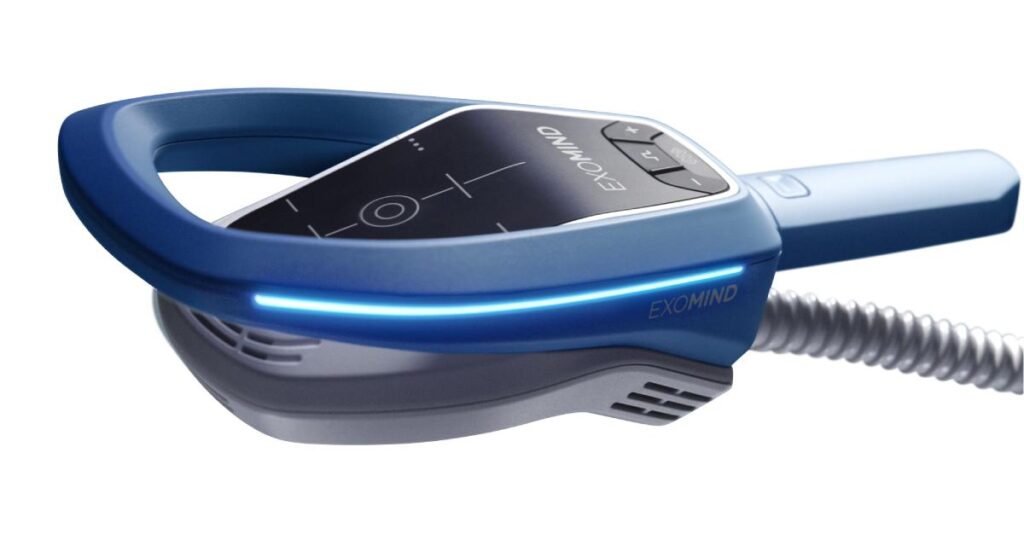
EXOMIND uses focused Electromagnetic pulses on the scalp to stimulate a small area on the left dorsolateral prefrontal cortex.
The goal is to support mood, focus, and sleep regulation. It is not surgery and it does not send electricity through the body. No sedation is used for this outpatient treatment.
A typical session takes about 25 minutes, and you walk out after brief checks. Dosing is set by motor threshold and adjusted for comfort over sessions. Doctor-led screening and dosing monitored by Dr Anjali Ghatge.
Why safety matters most for working adults 30–55
“Safety is a process, not a claim.” It matters because your week is full, your health has context, and your recovery window is short.
- Tight calendar with back-to-back calls. You need predictable sessions and a clear walk-out plan.
- Medication load to consider. Antidepressants, thyroid, or blood pressure medicines can shape eligibility and dose.
- Fear of downtime. You cannot risk brain fog or a sore scalp that lingers into meetings.
Most people return to work the same day.
Screening catches rule-outs before day 1. A doctor reviews your history, checks for metal or implanted devices near the head, past seizures or conditions that raise risk, recent head injury, pregnancy, and current medicines.
A short motor-threshold test sets a safe starting dose and helps adjust for comfort over sessions. If EXOMIND is not a fit, you will know before treatment begins.
Safety at GCD Clinic: how we control risk
EXOMIND is an outpatient treatment and does not use anesthesia for routine sessions. Contraindications and dose limits follow expert safety guidance for magnetic stimulation.
Our safety steps
- Medical history review
- Medication review for interactions and seizure-threshold factors
- Motor threshold test to set a personalized starting dose
- Gradual comfort ramp in the first few visits
- Ear protection when needed
- In-room session monitoring with periodic comfort checks
- Planned check-ins at session 3 and session 6
- Pause and reassess rules if you feel sensitive at any point
Indications can vary by device and geography. Screening decides fit.
For working professionals, I green light treatment when screening shows a safe fit and a plan that respects work and rest. We start at motor threshold and adjust for comfort.
— Dr Anjali Ghatge
What a session feels like and how long it takes
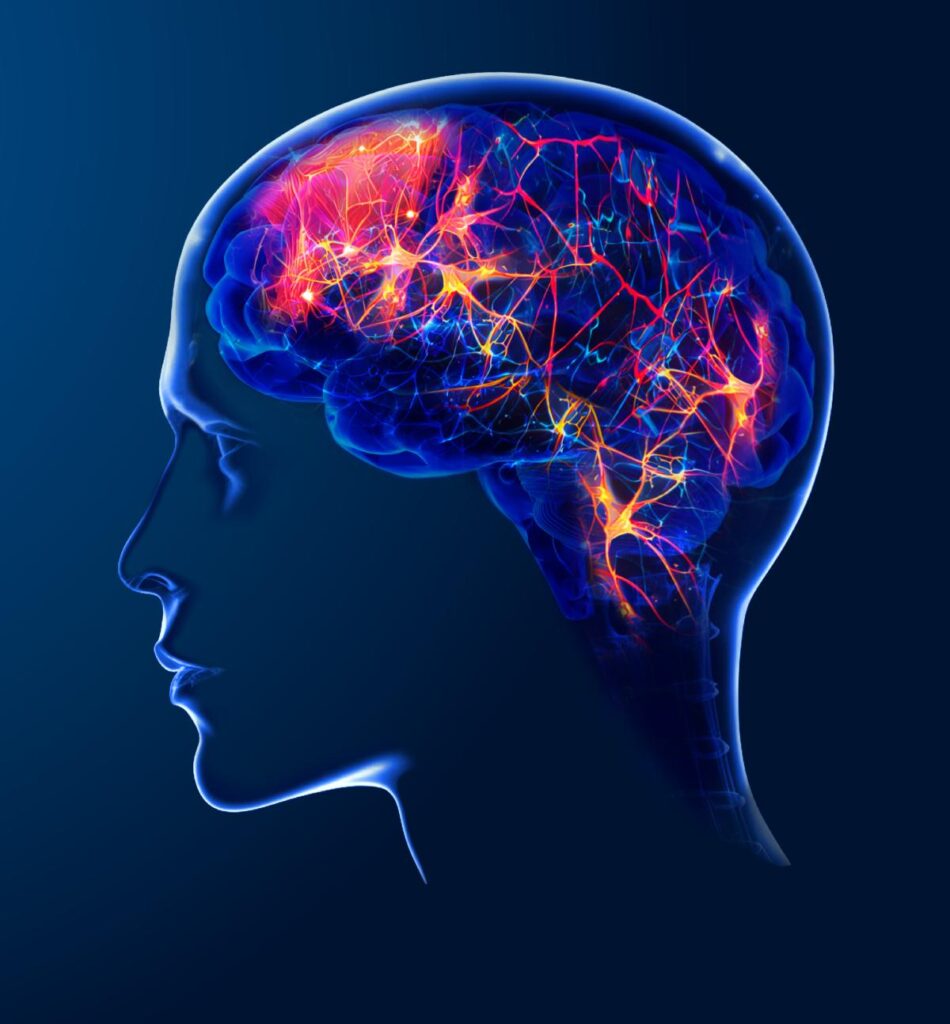
You sit in a quiet room with a recliner and a small treatment coil. A clinician explains each step before it starts so you know what you may feel. Ear protection is offered if the clicking seems loud.
The team measures your motor threshold first. This is a quick test that helps set a safe, personalized dose. The goal is comfort and steady progress, not force. There is no sedation and you remain awake the whole time.
Most appointments block about 25 minutes depending on the protocol and device settings. The stimulation itself usually runs for about 25 minutes, in short trains with brief pauses to check on you.
You feel a tapping or light tingle on the scalp where the coil sits. A brief finger or forehead twitch can happen in some people. Staff check in during the session and can pause or adjust in real time if you feel sensitive.
After the session there is a quick scalp check. Hydration and a normal meal help you feel steady for the rest of the day. Most people plan sessions around office hours and travel back to work without special restrictions.
Step by step
- Positioning in a recliner for head and neck support
- Coil placement over the left prefrontal area and dose check against motor threshold
- Tapping or light tingle on the scalp with a clicking sound
- Brief finger or forehead twitch possible and expected
- Stimulation runs for about 25 minutes with periodic check ins
- Basic aftercare with a short room exit once you feel ready
Tips for comfort
- No caffeine and nicotine consumption 3-4 hours before and after the treatment.
- Consumption of alcohol and other psychoactives is strongly discouraged throughout the duration of weekly Exomind sessions.
- Limit caffeine just before the visit.
- Eat a normal meal so you feel steady.
- Tell the team if you feel sensitive so we adjust intensity in real time.
Book a short doctor consult to check if EXOMIND is right for you. Contact GCD Clinic.
Side effects, risks, and how we lower them
Electro-magnetic stimulation can occasionally have side effects that are usually short lived. We talk through them before day 1 so you know what to expect and what to do.
Common and short lived
- Scalp discomfort where the coil sits
- Brief headache after a session
- Fatigue later in the day
- Mild dizziness or light sensitivity
Tell the team if you feel any of these. We can adjust intensity, add short pauses, or stop and resume after a check. Many people find a drink of water and a normal meal helpful. Common effects and self care steps are described here.
Rare and serious
- Seizure in predisposed people is the rare serious risk, reported at under 0.01% per session in clinical use. Screening and dosing protocols are designed to keep this risk low.
How we lower risk at the clinic
- Screen for seizure history, implanted devices, recent head injury, and other rule outs
- Calibrate dose with a motor threshold test and review medicines that change seizure threshold
- Use ear protection when needed, check comfort in real time, and pause if you feel sensitive
- Follow peer reviewed safety procedures for parameters and contraindications.
Who must avoid or delay EXOMIND
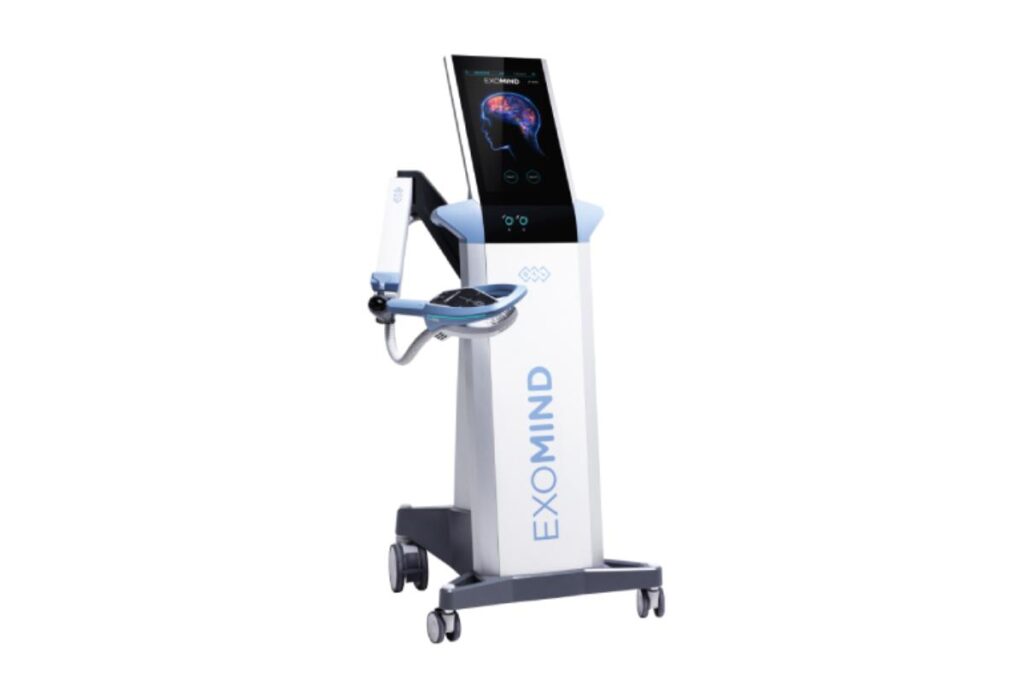
Safety comes first. Some people should not have magnetic stimulation, and some should wait until a doctor clears them. These rules follow device labeling and safety controls.
Metal and magnets do not mix near the head. If there is magnet-sensitive metal in the coil field, movement or heating is possible. That is why we ask detailed questions about past injuries and any surgical clips or plates.
Electrical implants can misbehave in strong magnetic fields. Even if an implant sits away from the head, the risk of interference is not worth it without device-specific clearance from your specialist.
Application over the chest or heart area is not done. The target is the left prefrontal region on the scalp, not the torso. Positioning protects both comfort and safety.
Do not treat
- Active electronic implants such as pacemakers, defibrillators, cochlear implants, deep brain stimulators
- Magnet-sensitive metal in or near the head within the coil field, for example aneurysm clips or metal fragments that cannot be removed
- Application over the chest or heart area
Caution or delay
- Recent head injury or concussion
- Psychotic disorders or unstable psychiatric conditions
- Decompensated medical illness such as uncontrolled hypertension or severe cardiac disease
- Pregnancy considerations that need an individual risk review
- New or unstable dosing of medicines that can lower seizure threshold
If you are in a caution group, timing matters. Many people clear once a condition stabilizes or a medicine change settles for a few weeks. Bring surgical cards and a current medicine list to the consult so screening is fast and accurate.
When in doubt, I pause and verify. A delayed start is safer than a rushed one.
— Dr Anjali Ghatge
Screening is designed to catch most rule-outs before day 1 so you do not begin unless it is safe to proceed. Doctor decides fit after consult.
The evidence and regulatory baseline
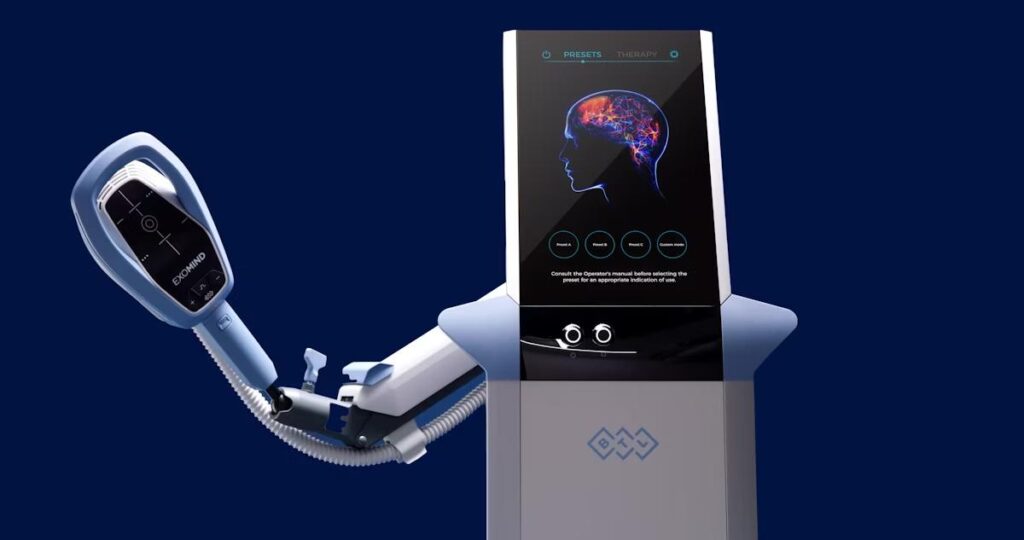
EXOMIND builds on repetitive transcranial magnetic stimulation, which has outpatient use in adults and no routine anesthesia in clinical settings. In the US, rTMS systems are Class II devices with special controls that spell out safety, labeling, and performance requirements. In the UK, guidance notes delivery as an outpatient procedure without anesthesia.
What this means for you
Special controls cover things like electrical and magnetic performance testing, electromagnetic compatibility, software validation, clear labeling for contraindications and warnings, and operator training. These create a baseline so clinics work within tested parameters.
Regulation sets the floor. Screening sets the standard. A clinic still needs good history taking, dose calibration by motor threshold, and comfort checks during sessions to keep risk low and the experience steady.
Helpful questions to ask at any clinic
- Which rTMS device model is used and is it operated within labeled parameters
- How is motor threshold measured and reviewed over time
- What are the pause rules and who monitors sessions in real time
Results and timeline: what people commonly notice
A standard course at our clinic is 6 sessions. Each session is repeated every 5 to 10 days or is done once a week, booked in a steady, predictable way.
Some people notice small shifts by session 2 or 3. Common early notes are calmer mornings, easier sleep onset, and steadier focus through routine tasks. Individual results vary, and clear changes often become easier to judge after 2 to 3 weeks of regular sessions.
By the end of the core program, your doctor will review sleep, focus, mood, and day function with you. Many people make decisions at this point. Some stop and watch. Some plan spaced boosters later if a doctor thinks it will help maintain gains. There is no one schedule that suits every adult.
Bring a simple tracker. A few lines each day about sleep onset, morning calm, ability to sit with tasks, and energy after lunch can make the review more objective.
Practical pairing with a work week
Most adults plan weekday visits around office hours. Visits are about 25 minutes including brief checks. You remain awake the whole time.
Simple guardrails
- Keep your existing medication plan unless your doctor advises a change
- No caffeine and nicotine consumption 3-4 hours before and after the treatment.
- Consumption of alcohol and other psychoactives is strongly discouraged throughout the duration of weekly Exomind sessions.
- Use a gentle cleanse after treatment if the scalp feels sensitive
- Stay well hydrated
Sleep and hydration matter. Aim for a regular bedtime, steady wake time, and at least two liters of water across the day unless your doctor advises otherwise. Consistency helps your body settle into the routine so sessions feel predictable and easier to stick with.
Cost, insurance, and administrative notes
Pricing varies by plan and by your clinical assessment. We do not post numbers to avoid mismatch. After screening, you can request a written quote that lists what is included and any optional add ons.
What your quote should spell out
- Per session rate or program price
- Number of planned sessions and review visits
- Reschedule or pause policy
- Receipt format for reimbursement claims
Insurance coverage in India for clinic based brain stimulation is limited. Plans differ, so check with your insurer for neuromodulation or mental health benefits and ask about pre authorization. Keep your medical notes and receipts ready for any claim.
“Price clarity beats guesswork. Ask for a written plan after screening.”
For a personal estimate, Contact GCD Clinic.
Myths and quick clarifications
| Myth | Fact |
|---|---|
| EXOMIND is the same as TMS | EXOMIND is a doctor led program built on rTMS principles and safety rules. |
| It is FDA approved | FDA clearances apply to rTMS devices and labeled indications. EXOMIND follows this safety framework and screens for fit. |
| Anesthesia is needed | No routine anesthesia for outpatient rTMS. You are awake and can speak during sessions. |
| It sends electricity through the body | The coil delivers targeted Electromagnetic pulses on only the left Dorsolateral Prefrontal Cortex of the brain. It is not like sending electricity simply through the body. |
| It is surgery | Non invasive. No cuts or stitches. |
| It hurts | Most people feel tapping or a light tingle. A brief headache can occur and often settles with rest or hydration. |
| It boosts memory and productivity for everyone | Some people report clearer focus and steadier mood over a course. Results vary and there are no guarantees. Keep a simple tracker to review changes with your doctor. |
Your 2 minute fit check
Routine beats intensity. Small, steady sessions are what count.
Use this quick checklist to see whether EXOMIND might fit your week and health.
Time and routine
- I can attend sessions 6 sessions. Each session is repeated every 5 to 10 days or is done once a week.
- The clinic commute works with my work hours
- No caffeine and nicotine consumption 3-4 hours before and after the treatment. Consumption of alcohol and other psychoactives is strongly discouraged throughout the duration of weekly Exomind sessions.
- I can keep a regular sleep and hydration plan
Health and safety
- I do not have active electronic implants such as a pacemaker or cochlear implant
- I do not have magnet sensitive metal in or near the head that cannot be removed
- I have not had a recent head injury or uncontrolled medical illness
- I do not have a seizure tendency, or I will bring this up for screening
Comfort and expectations
- I am okay with a tapping sensation on the scalp and brief check ins during the session
- I understand that results vary and are reviewed after the core program
- I will track simple markers like sleep onset, morning calm, and meeting focus
How to read your checks
- If most points are ticked and none of the safety items raise concerns, you may be a good candidate to review.
- If any safety item is unchecked, bring it up first. Screening decides fit.
FAQs About EXOMIND Being Safe For Middle Aged Professionals
For eligible adults it is considered safe when doctor led and protocol based. Screening decides fit.
You remain awake with no sedation. Plan a short buffer to see how you feel, then resume routine light activity. Screening decides fit.
Scalp discomfort or a brief headache are the most reported and often settle within a day. Mild headache occurs in about one quarter of people.
People with active electronic implants, magnet sensitive metal near the head, recent head injury, or seizure risk need careful screening. Screening decides fit.
Often yes. Your doctor will review medicines that can lower seizure threshold and coordinate with your therapist if needed. Screening decides fit.
Most people complete 6 sessions over 6 weeks, with early changes for some by the second or third visit. Screening decides fit.
Conclusion

Outpatient magnetic stimulation is designed for short visits, no sedation, and steady review so the experience stays predictable.
If you are a busy professional, safety is about the process, not a promise. Screening, motor-threshold dosing, and steady attendance are what keep risk low and the experience predictable.
If you want a calm, doctor-led review of your fit, book a consultation with Dr Anjali.
Bring your medicine list, a typical work week, and any sleep notes so the plan can be shaped to your day.
